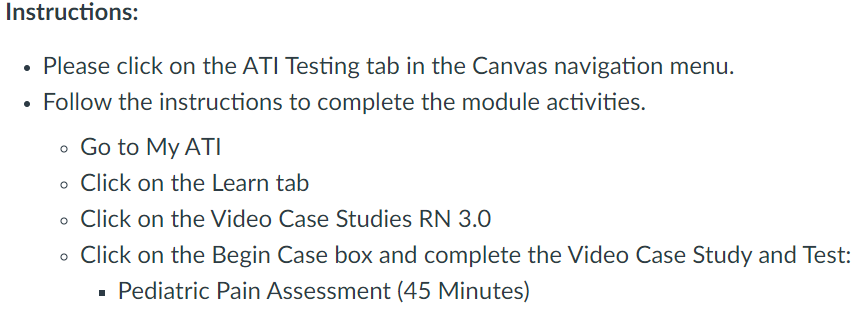 NUR109 M7.3: ATI-Video Case Studies: Paediatric Pain Assessment
NUR109 M7.3: ATI-Video Case Studies: Paediatric Pain Assessment
What is pain in a child?
Pain in a child is essentially what the child says it is. Unlike adults who can express their pain through a wide range of vocabulary, children may not have the same ability to articulate their discomfort. Therefore, it is crucial to listen to and believe what the child communicates about their pain, as their subjective experience is a key indicator.
What are common causes of pain?NUR109 M7.3: ATI-Video
Common causes of pain in children can include injury, various diseases, surgical procedures, and medical interventions. Children may experience pain from injuries like fractures or burns, medical conditions such as appendicitis or ear infections, or the pain associated with surgical procedures like tonsillectomies. It’s important to recognize and assess pain in these situations to provide appropriate care and relief.
What are the benefits of treating pain?NUR109 M7.3: ATI-Video
Treating pain in children has numerous benefits, including reducing anxiety, improving cooperation with healthcare professionals, lessening the fear of future medical procedures, and decreasing the need for restraints if pain and anxiety are well managed. Effective pain management not only improves the child’s experience but also contributes to better overall healthcare outcomes.
What does the acronym QUESTT stand for?NUR109 M7.3: ATI-Video
QUESTT is an acronym used to guide pediatric pain assessment and management. It stands for:
Question: Ask the child about their pain.
Use a reliable pain scale: Utilize appropriate pain assessment tools.
Evaluate behavior: Observe the child’s behavior for signs of pain.
Secure the parents’ involvement: Parents or caregivers can provide valuable information and emotional support.
Take the cause of pain into account: Understand the underlying cause of pain.
Take action to do something about it: Implement pain management strategies based on the assessment.
When should you reassess pain after medication?
Pain should be reassessed at specific intervals following medication administration to ensure its effectiveness. Reassessment should occur one hour after oral (PO) medication, 30 minutes after intramuscular (IM) medication, and 15-30 minutes after intravenous (IV) medications.
What age group is the CRIES pain scale appropriate for?
The CRIES pain scale is appropriate for the age group of newborns to 2 months. It’s designed to assess pain in very young infants who are unable to communicate their discomfort verbally.
When would you use the FLACC pain scale?
The FLACC pain scale is used for children between the ages of 2 months to 4 years, particularly when they are sedated or developmentally delayed. It assesses pain by evaluating facial expressions, leg movement, activity, cry, and consolability.
What age group is the Wong-Baker Faces Scale appropriate for?
The Wong-Baker Faces Scale is appropriate for children between the ages of 3 to 7 years. It uses a series of faces depicting different emotional expressions to help children express their pain levels.
With what age group would you use the numeric pain intensity scale?
The numeric pain intensity scale, which relies on numerical values to assess pain, is suitable for children over the age of 7 years old. It requires the child to have a basic understanding of numbers to use effectively.
With what age group may the FACES pain rating scale be used?
The FACES pain rating scale may be used with children aged 3 to 7 years. It uses a series of facial expressions ranging from happy to extremely sad to help children express their pain levels.
What are some cognitive nonpharmacological interventions for pain?
Cognitive nonpharmacological interventions for pain in children include relaxation techniques, distraction methods, imagery, biofeedback, thought-stopping, and positive self-talk. These strategies help children manage and cope with pain through mental and emotional processes.
What are some biophysical interventions for pain?
Biophysical interventions for pain include the application of heat and cold, as well as massage and pressure. These methods can provide relief and comfort to children experiencing pain, promoting relaxation and reducing discomfort.NUR109 M7.3: ATI-Video
If you or someone you know is seeking assistance with ATI testing or NCLEX Exam preparation for nursing, I encourage you to consider our services at fixmygpa.com. Our team of experienced professionals is dedicated to helping you achieve your nursing education and career goals. Whether it’s mastering complex nursing concepts, preparing for exams, or ensuring success in your nursing journey, we’re here to provide the support and guidance you need. Don’t hesitate to reach out; let us help you on your path to success in the nursing field.


